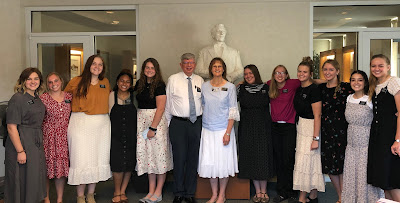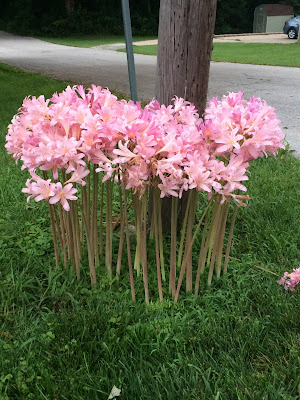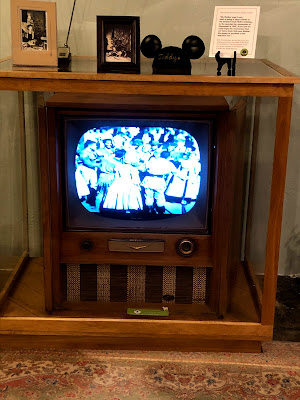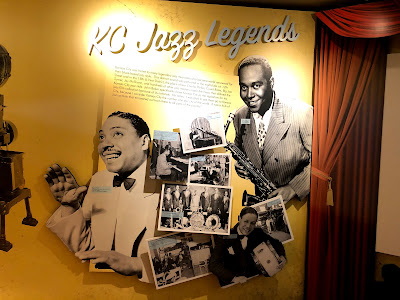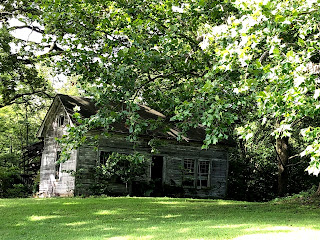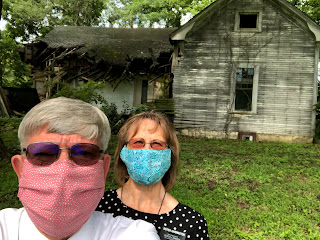Week 50--August 2-8, 2020
These beautiful angels practice the Prayer Dance. They almost have it perfected.
Front: Sister Wilson, Sister Anderson, Sister Kinikini, Sister Brock, and Sister Martin.
Middle: Sister Galbraith, Sister Burdge, Sister Greenwood, and Sister Bates.
Back: Sister Randall and Sister Kinne.
On Saturday we visited the Negro Baseball League Museum and the American Jazz Museum. The map shows all the cities that a Negro Baseball team.
One of the the things that hasn't changed about baseball over the years is the size of the ball and the way they are made.
This display case shows the equipment used by the catcher. Notice the shin guards that were first made from barrel slats.

Shin guards later.
The catcher's mitt looks more like a hot pad than a mitt, And the fielder's glove looks more like one you'd use for work.Bus for the a negro baseball team.
In 1952 the Indianapolis Clowns signed a promising rookie nicknamed "Pork Chop". He was given his nickname because he ate only pork chops and French fires on the road. "Pork Chop" went on to become one of the most celebrated black baseball players in the game, Henry "Hank" Aaron.
Negro Baseball teams hired women players. The best known were Connie Morgan, Toni Stone, and Mamie Johnson.
Night baseball was started by the Negro Baseball League. It made it possible for more fans to come to the games. The lights made it more difficult for the players to see the ball, but the fans loved it.
Geddy Lee collection of baseballs autographed by Negro League veterans.
Tom and Garnalee at the Negro Baseball League Museum.
About the only thing we knew about the history of negro baseball was that Jackie Robinson broke the color barrier when he became the first major league baseball player. Of course we know Hank Aaron, Willie Mays, and Barry Bonds, but there were hundreds of great players. The hardships they endured for the love of the game was inspiring.
After the baseball museum we walked across the building to the American Jazz Museum. The museum was equipped with listening stations, interactives, and custom mixing boards making the jazz accessible and engaging.
Kansas City was home to many legendary jazz musicians who became world renowned for their blues-base jazz style. The distinct sound was perfected in the 18th and Vine District, the place where Charlie (Bird) Parker, Count Basie, Big Joe Turner, and hundreds of other jazz masters made music that defined the Kansas City style. Many considered Kansas City the number one jazz city of the world.
18th and Vine Historic District. This area was the home to many African Americans before and during the segregation era.
One beautiful saxophone.
Included in the museum was an entire wing commemorating Charlie Parker and what would have been his 100th birthday.
At the front of the wing is a saxophone given to the museum and signed by former President Bill Clinton.
We were both humbled by our incredible lack of knowledge about Jazz music and its history. We know a little more now. It was a fun tour.
While Utah and Idaho are burning up with temps of 100+, our days have been gorgeous and temperatures are in the 80s. It's a lot more humid in Missouri than out west, but not intolerable.
Tuesday of this week we (the senior couples and all 11 of the historic sites junior missionaries) did a service project for Billion Graves at the Washington Cemetery here in Independence. This time we took scissors to more neatly trim the overgrown grass. We photoed and then documented 34 grave stones. We probably added 300 new records to the archive today.
Wednesday is dinner and a movie night here in the mission. The seniors stay in Theater 1, and the juniors go to Theater 2. (We've been asked to separate for our protection.) Last week we saw The Fighting Preacher and this week was A Rare Possession (the Vicenzo de Francesco story). Its always fun to visit, enjoy a good meal, and watch a good movie.
Thursday we had scheduled a tour with a woman and her son from Honduras, so I gave the tour in Spanish. (We can only discuss the history of the site outside.) After a twenty minute spiel about how this area was dedicated by the Prophet Joseph Smith and was Zion, the woman asked, "Who is Joseph Smith?" Oops! Well, in 1820 a 14 year old boy . . . . We gave her a Spanish copy of the Book of Mormon and encouraged her to continue to visit with the missionaries in her new home in Georgia.
Another fun thing we missionaries get to do is to have a Zoom discussion about one of the many historic sites. This week's tour was Sharon Vermont, the birthplace of Joseph Smith. We've also had virtual tours like the one from San Diego with the Mormon Battalion. The young sisters do a great job, and we don't have to travel to get a great tour.
Friday we gave our "Book Club" presentation to the junior sisters. This week was Saints, Chapters 20 & 21. Tom did 20, Garnalee did 21. After the two chapters, Garnalee had made a crossword puzzle using key words from the chapters to review. It was lots of fun and it was the last one we'll do.
We've started memorizing The Proclamation on The Restoration of the Fullness of the Gospel of Jesus Christ. Garnalee is much better at it than Tom. We've only just begun and will do one paragraph per week. This mission has been a wonderful experience and we're loving it!










